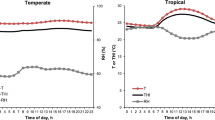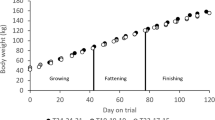Abstract
The effect of ambient temperature on diurnal rhythm of metabolic rate and activity was studied in group housed pigs in two trials. Two climate controlled respiration chambers were used, one for each trial. Each chamber contained two groups of 8 pigs. During the experiment of 31 days the mean live weight of the animals increased from 28 to 40 kg. Feeding level was kept constant at 93 kg−0.75. d−1. Feed contained 12 kJ of metabolizable energy per g. Temperature treatment started with 20‡C for two days. After that it was lowered in stepwise fashion by 4K to 16, 12 and 8‡C. Each temperature treatment lasted two days. After that temperature it was increased in steps to 20‡C in 8 days. The whole procedure was repeated once. Metabolic rate and activity were measured continuously during the 24 hrs of every second day of the temperature treatment.
Metabolic rate increased at temperatures below 16‡C. Activity was associated with ambient temperature. At low temperature, the total activity related heat production was increased, especially during day time. Variation in metabolic rate within a day was not reduced by low ambient temperature. Thermal requirement, calculated as lower critical temperature, was about 14‡C as averaged over the day, (16.1‡C during day time and 13.6‡C during night time). Extra thermal heat production below thermoneutrality was affected by time of day and activity.
Similar content being viewed by others
References
BALSBAUGH, R. K. and CURTIS, S. E. (1979): Operant supplemental heat by pigs, Abstract no 91. 71st Annual meeting ASAS, University of Arizona, Tucson.
CLOSE, W. H. (1971): Nutrition Environmental interaction of growing pigs. Ph.D. Thesis pp. 1–238. Queens University of Belfast.
CLOSE, W. H. (1982): The climatic requirement of the pig, pp. 149–166. In: Environmental Aspects of Housing for Animal Production (ed. J. A. Clark), Butterworths, London.
CÖP, W. A. G. (1974): Protein and fat deposition in relation to body weight gain and feeding level. Med. Landbouwhogeschool Wageningen 74-18: 1–71.
HALTER, H. M., WENK, C. and SCHÜRCH, A. (1980): Effect of feeding level and feed composition on energy utilisation, physical activity and growth performance of piglets. In: Studies in Agricultural and Food Science. L. E. Mount (ed.) Butterworths, London: 395–398.
HOLMES, C. W. and CLOSE, W. H. (1977): The influence of climatic variables on energy metabolism and associated aspects of productivity in the pig. In: Nutrition and the Climatic Environment (eds. W. Haresign, H. Swan and D. Lewis), Butterworths, London pp. 51–74.
McCRACKEN, K. I. and CALDWELL, B. J. (1980): Studies on diurnal variations of heat production and the effective lower critical temperature of early weaned pigs under commercial conditions of feeding and management. Brit. J. Nutr., 43: 321–328.
MOUNT, L. E. and WILLMOTT, JANE, V. (1967): The relation between spontaneous activity, metabolic rate and the 24-hour cycle in mice at different environmental temperature. J. Physiol. Lond. 190: 371–380.
MOUNT, L. E. (1979): Adaptation to thermal environment. Man and his Productive Animals, Ed. Arnolds, London.
VERSTEGEN, M. W. A. and van der HEL, W. (1974): The effects of temperature and type of floor on metabolic rate and effective critical temperature in groups of growing pigs. Anim. Prod., 18: 1–11.
VERSTEGEN, M. W. A., van der Hel, W., Brandsma, H. and Wallinga, J. H. (1983): Indirect calorimeters for large groups of animals; in preparation.
WENK, C. and van ES, A. J. H. (1976): Eine Methode zur Bestimmung der Energieaufwandes für die Körperliche Aktivität von wachsenden Küken. Schweiz. Landwirt. Monatshelfte, 54: 232–236.
Author information
Authors and Affiliations
Rights and permissions
About this article
Cite this article
van der Hel, W., Verstegen, M.W.A., Baltussen, W. et al. The effect of ambient temperature on diurnal rhythm in heat production and activity in pigs kept in groups. Int J Biometeorol 28, 303–315 (1984). https://doi.org/10.1007/BF02188557
Received:
Revised:
Issue Date:
DOI: https://doi.org/10.1007/BF02188557




